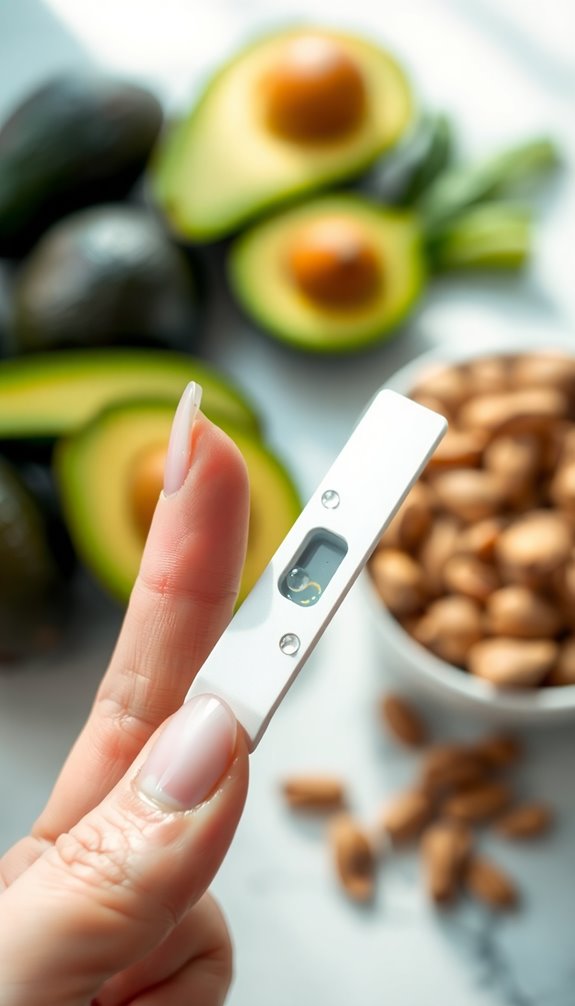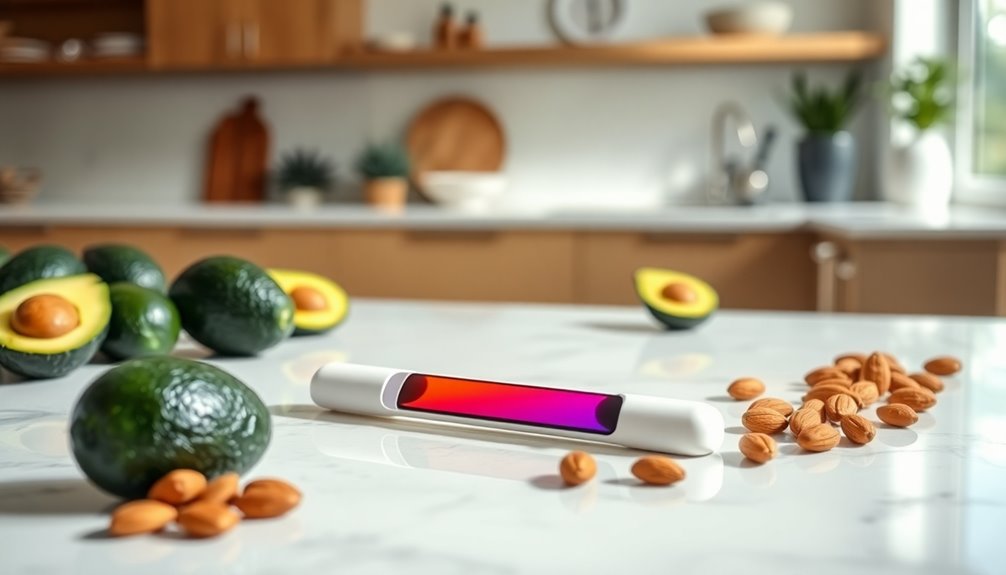Keto strips are handy tools that let you monitor your ketone levels and check if you're in ketosis while on a ketogenic diet. They work by detecting acetoacetate in your urine, providing a visual color change that indicates your ketone concentration. For the best results, test your ketones in the morning or after meals, and stay hydrated to avoid diluted readings. These strips are great for beginners looking to gauge dietary adherence, but keep in mind they're less accurate than blood meters as your body adapts. Keep going to discover more on using and understanding these effective strips!
Understanding Ketosis

Understanding ketosis is key to successfully steering a ketogenic lifestyle. The process of ketosis significantly enhances insulin sensitivity, which is crucial for maintaining stable blood sugar levels and overall metabolic health. Additionally, a well-formulated ketogenic diet can lead to improved glucose regulation, further supporting metabolic health. This metabolic shift to utilizing ketones for fuel also reduces the body's reliance on glucose, making it easier to manage blood sugar levels effectively.
What Are Keto Strips?
Keto strips are handy diagnostic tools you can use to check if your body is in ketosis by testing your urine for acetoacetate, a type of ketone body.
These urine test strips provide a color-coded result that corresponds to ketone concentration, making it easy for you to estimate your level of ketosis. When you use keto strips, you simply dip the strip into a urine sample and wait for the color change, which indicates your ketone levels. Additionally, using keto strips can help you monitor your progress in improving insulin sensitivity, an important aspect of the Keto Diet. Regularly checking your ketone levels can also inform you about your carbohydrate intake, ensuring that you remain within your dietary goals.
You can find keto strips over-the-counter in drugstores or online, typically priced between $5 and $15. While they give you a quick snapshot of your ketogenic state, keep in mind that their accuracy can be influenced by factors like hydration levels. If your urine is diluted, it might show lower readings, even if you're in ketosis.
Though keto strips aren't a precise measurement, they serve as a practical initial check for those following a ketogenic diet. They help you verify that your carbohydrate intake is low enough to induce ketosis, allowing you to adjust your diet accordingly. Additionally, maintaining a balanced triglyceride level is essential for overall cardiovascular health while on a ketogenic diet.
How Keto Strips Work

Keto strips help you monitor your ketosis by detecting acetoacetate in your urine.
You'll interpret the color changes to understand your ketone levels, but keep in mind that hydration can affect the results. Additionally, the production of ketones during ketosis serves as an alternative energy source, which can influence your readings. Timing your tests is also essential for getting accurate readings as your body adapts to this low-carb lifestyle. Additionally, monitoring your ketone levels can provide insights into your insulin sensitivity and overall metabolic health as you progress on the keto diet.
Testing Methods Explained
When you're looking to check your state of ketosis, keto strips offer a simple and effective method to measure acetoacetate levels in your urine.
Using these strips is straightforward: you dip the strip into your urine, wait a few seconds, and observe the color change. This color shift indicates your ketone levels, with darker colors signaling higher concentrations of ketones.
To get the most precise results, consider the following tips:
- Test your urine in the morning or after dinner for ideal accuracy.
- Follow the manufacturer's instructions carefully to guarantee proper usage.
- Maintain consistent hydration levels to avoid diluting your ketones.
- Store the strips in a cool, dry place to prevent degradation.
- Remember that while keto strips are convenient, they provide a preliminary check, not a definitive measurement.
Interpretation of Results
Understanding how to interpret the results from your keto strips is key to effectively monitoring your ketosis levels. These strips test your urine for acetoacetate, a type of ketone body. When you dip the strip in your urine, you'll notice a color change, which correlates with your ketone levels. Darker colors indicate higher concentrations of ketones, suggesting that you're successfully in ketosis.
If you're following a low-carb diet, moderate to high readings can signal that your body is efficiently burning fat for fuel. However, if you're not on a ketogenic diet, normal results should show little to no ketones.
Be cautious, though—hydration can affect your results. Diluted urine might yield lower readings, impacting the accuracy of your ketosis assessment.
While keto strips are a great starting point for monitoring, they're less reliable for long-term tracking. Blood ketone meters provide more precise measurements for those serious about evaluating their ketosis levels.
To summarize, keep an eye on the color change, stay mindful of hydration, and consider shifting to blood tests for a more accurate picture of your ketone levels over time.
Timing for Testing
Timing is essential for getting accurate readings from your keto strips. To effectively gauge your ketone levels, it's important to establish a consistent routine. The best times for ketone testing are in the morning or after meals. These times usually yield more stable results because your hydration levels are more consistent.
Here are a few tips to enhance your timing for testing:
- Test first thing in the morning before eating or drinking.
- Avoid large water intake right before testing to prevent diluted results.
- Stick to a daily testing schedule to track trends.
- Consider testing after meals to see how your body reacts.
- For those adapting into ketosis, test every few days.
Types of Ketone Measurement
Ketone measurement methods vary in accuracy, convenience, and purpose, making it essential to choose the right one for your needs. You've got a few options: urine strips, blood ketone meters, and breath analyzers. Each method has its own strengths and weaknesses.
Urine strips are often the go-to choice for beginners. They test for acetoacetate and are quite affordable, but keep in mind that their accuracy decreases as your body becomes more efficient in ketosis. As your body adapts to using fat as the primary energy source, understanding insulin sensitivity becomes crucial for optimizing your overall metabolic health. Additionally, individuals on the keto diet should be aware of how different fat types can influence their cholesterol levels.
If you're looking for reliable results, a blood ketone meter is your best bet. These devices measure beta-hydroxybutyrate, giving you a clear picture of your ketosis levels, which should ideally fall between 0.5 to 3.0 mmol/L. Additionally, regular monitoring of your ketone levels can provide insights into how well you're managing your cholesterol levels on the keto diet.
Breath analyzers offer a non-invasive alternative by detecting acetone levels in your breath. While they're less common than urine or blood tests, they can provide a rough estimate of your ketone production.
Ultimately, urine strips may be helpful for early monitoring, but if you're serious about tracking your progress in the long term, a blood ketone meter is recommended. Evaluate your needs to determine which method suits you best.
Benefits of Using Keto Strips

Keto strips offer a cost-effective and convenient way to gauge your ketone levels through urine testing. By simply dipping a strip into your urine, you can visually track your progress and guarantee you're in a state of ketosis.
Here are some key benefits of using keto strips:
- Visual feedback: Watch the color change on the strip, indicating concentration of acetoacetate.
- Dietary adherence: Confirm that your carbohydrate intake is low enough to maintain ketosis.
- Guidance for beginners: Monitor your initial rise in ketone levels as you start your ketogenic journey, which is crucial for achieving metabolic changes that promote hormonal balance. Engaging in regular physical activity while using keto strips can further enhance your metabolic state and support heart health.
- Optimize macronutrient intake: Adjust your diet based on real-time feedback from your ketone levels.
- Early warning system: Detect elevated ketone levels to help avoid diabetic ketoacidosis (DKA), especially important for those with type 1 diabetes.
- Using keto strips can also help ensure improved insulin sensitivity, which is vital for managing blood sugar levels effectively.
Using keto strips not only aids in optimizing your diet but also provides peace of mind as you manage your health.
Limitations of Keto Strips
While keto strips can be a useful tool for tracking your ketone levels, they come with several limitations that can impact their effectiveness.
First, keto strips primarily test for acetoacetate in urine, which doesn't always accurately reflect your blood ketone levels. This discrepancy becomes more pronounced as you adapt to a ketogenic diet. Furthermore, your hydration levels greatly influence the concentration of ketones in your urine; being over or under-hydrated can lead to misleading results.
Additionally, if you consume a high-protein diet, the excess protein might convert to glucose, potentially lowering ketone excretion in your urine, making keto strips less effective. As your body becomes more efficient at utilizing ketones, urine levels may decrease even when you're still in ketosis, suggesting that blood ketone meters could provide more reliable long-term monitoring.
Finally, frequent testing with keto strips can lead to obsessive behaviors around diet adherence. You might find yourself frustrated by their varying accuracy and limitations, which can detract from your overall experience on the ketogenic diet. Moreover, understanding your insulin sensitivity can further inform how your body processes ketones during your ketogenic journey.
Keeping these factors in mind can help you make more informed decisions about tracking your ketone levels.
Testing Best Practices

To achieve the most accurate readings from your keto strips, it's crucial to establish a consistent testing routine. You should aim to test at the same times each day, like early morning or after dinner. This consistency helps you monitor your ketone levels effectively.
Here are some best practices to keep in mind:
- Stay hydrated: Drink enough water before testing to avoid concentrated urine that can skew results.
- Follow instructions: Always adhere to the manufacturer's guidelines to guarantee proper usage and accurate readings.
- Check expiration dates: Regularly verify that your strips are within their expiration period to avoid misleading results.
- Test at the right times: Using strips after meals can provide insights into how your body reacts to food.
- Consider your experience level: If you're new to the ketogenic diet, urine strips are a cost-effective option. More experienced users might prefer blood ketone meters for precision.
Health Considerations for Ketosis
Many people find that ketosis offers significant benefits for weight loss and metabolic health, but it's important to be aware of potential risks. While you may enjoy rapid fat loss, ketosis can lead to nutrient deficiencies, hypoglycemia, and digestive issues if not carefully managed. Regular monitoring is crucial to track your body's response and mitigate these risks.
During the initial adaptation phase, you might experience symptoms of keto flu, including fatigue, dizziness, and irritability. Staying hydrated and maintaining your electrolyte balance can help ease these side effects.
If you have diabetes, monitoring your blood sugar levels becomes even more critical to prevent complications like high ketone levels and ketoacidosis.
Before starting a ketogenic diet, it's wise to consult with a healthcare provider. They can help ascertain that ketosis aligns with your individual health needs and guide you in managing potential risks effectively.
Conclusion
To sum up, keto strips can be your handy tool on the journey to ketosis. They help you measure ketone levels, providing instant feedback as you adjust your diet. While they offer valuable insights, remember they're just one piece of the puzzle. With proper testing and awareness of their limitations, you can fine-tune your approach. So, grab those strips, stay informed, and enjoy the process of finding what works best for you in achieving your health goals.







